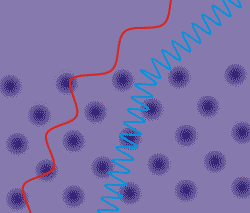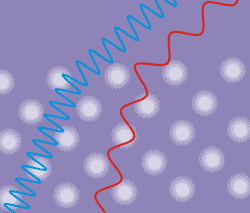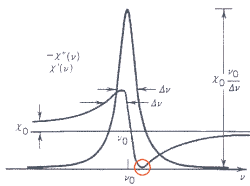The modeling of vacuum by light spreading through material environment isn't completely new here. For example the recent experimental work demonstrated by sending of ultrashort pulses into foamy structure of optical fibers the blue-shifting of light at a white-hole horizon. Recently whole area of physics named transformation optics was established on analogy of physics of vacuum in gravity field to spreading of waves in media of variable refraction index (which was one of Einstein's "refractive approaches" to gravitational light bending and general relativity, by the way).
Metamaterial character of vacuum was proposed before two years and recent publication described the way, how to model structures like gravitational lensing, strange attractors, streaks of dark matter, photon sphere or event horizons of black holes by infrared waves spreading through porous GaInAsP metamaterial sponge. In context of existing theories these analogies are rather ad-hoced, but they've deep meaning in context of AWT, which describes vacuum as a dense system of particles, composed of nested fluctuations, which are having structure of fractal sponge or foam. Therefore the metamaterial nature of vacuum belongs between significant predictions of AWT.
The understanding the role of foamy structure of vacuum fluctuations (as manifested by CMB radiation, soliton character of gamma bursts or ZP energy) in metamaterial character of vacuum is quite easy, if we consider Aether concept. In inhomogeneous environment so called Rayleigh dispersion occurs, whenever the positive surface curvature of density fluctuations prevails. In such system the waves are dispersed (absorbed and refracted) the more, the shorter is their wavelength, because short waves cannot avoid obstacles so easily. From this reason both the absorption coefficient, both the refracting index of environment increases with increasing frequency of radiation - this is so called normal dispersion.
The materials with negative curvature fluctuations of Emental cheese structure are less common, but in such environment the relation of absorption and refraction curve is exactly as opposite, because in such environment the refraction index decreases with increasing frequency with compare to absorption, so we are talking about "anomalous dispersion" here.
The absorption and dispersion curves are mutually related by Kramers-Kronig relations, by which absorption curve (bulk effect) is the first derivation of dispersion curve (i.e. the surface refraction effect), because in environment modeled by spherical particle fluctuations the surface of sphere is first derivation of sphere volume with respect to radius. In vacuum environment the absorption and dispersion curve of electric and magnetic waves corresponds the real and imaginary portion of complex quantities called permitivity and permeability of vacuum, accordingly.
With respect to space-time definition the negative portion of dispersion curve close to inflection point is most significant (compare the red point on the dispersion curve above), because for such frequency the energy spreads in slowest speed possible, so that the space-time appears most huge from insintric perspective here. Such environment has a structure of foam, where positive curvature of density fluctuations remains balanced by negative curvature of holes, but not quite - from this the symmetry violation of vacuum foam follows and the environment behaves like metamaterial of negative refraction index, whenever the imaginary portion of both permeability, both permitivity remains negative. We can say, vacuum behaves like metamaterial just because it's so huge due the presence of large amount of density fluctuations, so we can model phenomena like dark matter streaks, photons and event horizon of black holes by light spreading through metamaterials of foamy structure (compare the simulation bellow).

With compare to solid state metamaterials vacuum is composed of fractal foam of density fluctuations similar to Perlin octal noise, because Aether is behaving like elastic fluid filled/formed by its vortices and the diameter of vortices is indirectly proportional to frequency of wave perturbations. This leads to metamaterial character of vacuum in broad range of wavelengths, until we use transversal waves of minimal exsintric speed for observation. Because metamaterial focuses wave into solitary wave packets (i.e. bosons), we can see the distant stars like pin-point objects without dispersion in broad range of spectrum from infrared to X-ray range of EM wave spectrum.
From general perspective, the normal and anomalous dispersion should be symmetric phenomena. The usage of word "normal" in this context is anthropocentric, because it's based on the fact, human creatures are formed by density fluctuations of arbitrarily positive curvature (i.e. by particles in common sense), so we can interact with particle fields more often and easily, then with fluctuations of negative curvature. Inside of atom structures the positive and negative curvature of electron orbitals remains balanced, so we can observe both absorbance peaks, both transmittance peaks with the same probability there.








Žádné komentáře:
Okomentovat
Poznámka: Komentáře mohou přidávat pouze členové tohoto blogu.